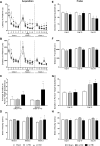Greater neurobehavioral deficits occur in adult mice after repeated, as compared to single, mild traumatic brain injury (mTBI)
- PMID: 26542813
- PMCID: PMC11817748
- DOI: 10.1016/j.bbr.2015.10.052
Greater neurobehavioral deficits occur in adult mice after repeated, as compared to single, mild traumatic brain injury (mTBI)
Abstract
Mild traumatic brain injury (mTBI) accounts for the majority of all brain injuries and affected individuals typically experience some extent of cognitive and/or neuropsychiatric deficits. Given that repeated mTBIs often result in worsened prognosis, the cumulative effect of repeated mTBIs is an area of clinical concern and on-going pre-clinical research. Animal models are critical in elucidating the underlying mechanisms of single and repeated mTBI-associated deficits, but the neurobehavioral sequelae produced by these models have not been well characterized. Thus, we sought to evaluate the behavioral changes incurred after single and repeated mTBIs in mice utilizing a modified impact-acceleration model. Mice in the mTBI group received 1 impact while the repeated mTBI group received 3 impacts with an inter-injury interval of 24h. Classic behavior evaluations included the Morris water maze (MWM) to assess learning and memory, elevated plus maze (EPM) for anxiety, and forced swim test (FST) for depression/helplessness. Additionally, species-typical behaviors were evaluated with the marble-burying and nestlet shredding tests to determine motivation and apathy. Non-invasive vibration platforms were used to examine sleep patterns post-mTBI. We found that the repeated mTBI mice demonstrated deficits in MWM testing and poorer performance on species-typical behaviors. While neither single nor repeated mTBI affected behavior in the EPM or FST, sleep disturbances were observed after both single and repeated mTBI. Here, we conclude that behavioral alterations shown after repeated mTBI resemble several of the deficits or disturbances reported by patients, thus demonstrating the relevance of this murine model to study repeated mTBIs.
Keywords: Behavior; Learning and memory; Mild; Repetitive; Sleep; Traumatic brain injury.
Copyright © 2015 Elsevier B.V. All rights reserved.
Conflict of interest statement
The authors declare no conflicts of interest.
Figures






Similar articles
-
The spectrum of neurobehavioral sequelae after repetitive mild traumatic brain injury: a novel mouse model of chronic traumatic encephalopathy.J Neurotrauma. 2014 Jul 1;31(13):1211-24. doi: 10.1089/neu.2013.3255. Epub 2014 Jun 12. J Neurotrauma. 2014. PMID: 24766454 Free PMC article.
-
Cerebrolysin improves cognitive performance in rats after mild traumatic brain injury.J Neurosurg. 2015 Apr;122(4):843-55. doi: 10.3171/2014.11.JNS14271. Epub 2015 Jan 23. J Neurosurg. 2015. PMID: 25614944
-
The effect of an acute systemic inflammatory insult on the chronic effects of a single mild traumatic brain injury.Behav Brain Res. 2018 Jan 15;336:22-31. doi: 10.1016/j.bbr.2017.08.035. Epub 2017 Aug 30. Behav Brain Res. 2018. PMID: 28855139
-
Repeated Mild Traumatic Brain Injury: Potential Mechanisms of Damage.Cell Transplant. 2017 Jul;26(7):1131-1155. doi: 10.1177/0963689717714092. Cell Transplant. 2017. PMID: 28933213 Free PMC article. Review.
-
Functional MRI of mild traumatic brain injury (mTBI): progress and perspectives from the first decade of studies.Brain Imaging Behav. 2012 Jun;6(2):193-207. doi: 10.1007/s11682-012-9173-4. Brain Imaging Behav. 2012. PMID: 22618832 Free PMC article. Review.
Cited by
-
Repetitive mild traumatic brain injury alters diurnal locomotor activity and response to the light change in mice.Sci Rep. 2019 Oct 1;9(1):14067. doi: 10.1038/s41598-019-50513-5. Sci Rep. 2019. PMID: 31575951 Free PMC article.
-
Astrocyte-mediated mechanisms contribute to traumatic brain injury pathology.WIREs Mech Dis. 2023 Sep-Oct;15(5):e1622. doi: 10.1002/wsbm.1622. Epub 2023 Jun 18. WIREs Mech Dis. 2023. PMID: 37332001 Free PMC article. Review.
-
Animal models of chronic traumatic encephalopathy.Concussion. 2017 May 19;2(2):CNC32. doi: 10.2217/cnc-2016-0031. eCollection 2017 Jun. Concussion. 2017. PMID: 30202573 Free PMC article. Review.
-
Inflammasome links traumatic brain injury, chronic traumatic encephalopathy, and Alzheimer's disease.Neural Regen Res. 2025 Jun 1;20(6):1644-1664. doi: 10.4103/NRR.NRR-D-24-00107. Epub 2024 Jul 10. Neural Regen Res. 2025. PMID: 39104096 Free PMC article.
-
Characterization of apathy-like behaviors in the 5xFAD mouse model of Alzheimer's disease.Neurobiol Aging. 2023 Jun;126:113-122. doi: 10.1016/j.neurobiolaging.2023.02.012. Epub 2023 Mar 2. Neurobiol Aging. 2023. PMID: 36989547 Free PMC article.
References
-
- Centers for Disease Control and Prevention. Report to congress on traumatic brain injury in the United States: Epidemiology and rehabilitation. National Center for Injury Prevention and Control; Division of Unintentional Injury Prevention; 2014.
-
- Faul M, Xu L, Wald MM, Coronado m VG. Traumatic brain injury in the United States: emergency department visits, hospitalizations, and deaths. Centers Dis Control Prev Natl Center Injury Prev Control. 2010
-
- Langlois JA, Rutland-Brown W, Wald MM. The epidemiology and impact of traumatic brain injury: a brief overview. J Head Trauma Rehab. 2006;21:375–378. - PubMed
-
- Guskiewicz KM, Marshall SW, Bailes J, McCrea M, Cantu RC, Randolph C, et al. Association between recurrent concussion and late-life cognitive impairment in retired professional football players. Neurosurgery. 2005;57:719–726. - PubMed
Publication types
MeSH terms
Grants and funding
LinkOut - more resources
Full Text Sources
Other Literature Sources
Miscellaneous

